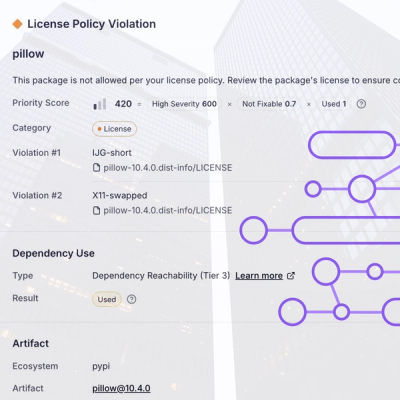
Research
/Security News
Critical Vulnerability in NestJS Devtools: Localhost RCE via Sandbox Escape
A flawed sandbox in @nestjs/devtools-integration lets attackers run code on your machine via CSRF, leading to full Remote Code Execution (RCE).
|image| |Coverage Status|
While dependency injection is easy to do in Python due to its support for keyword arguments, the ease with which objects can be mocked and its dynamic nature, a framework for assisting in this process can remove a lot of boiler-plate from larger applications. That’s where Injector can help. It automatically and transitively provides dependencies for you. As an added benefit, Injector encourages nicely compartmentalised code through the use of modules.
If you’re not sure what dependency injection is or you’d like to learn more about it see:
The Clean Code Talks - Don’t Look For Things! (a talk by Miško Hevery) <https://www.youtube.com/watch?v=RlfLCWKxHJ0>__Inversion of Control Containers and the Dependency Injection pattern (an article by Martin Fowler) <https://martinfowler.com/articles/injection.html>__The core values of Injector are:
Simplicity - while being inspired by Guice, Injector does not slavishly replicate its API. Providing a Pythonic API trumps faithfulness. Additionally some features are omitted because supporting them would be cumbersome and introduce a little bit too much “magic” (member injection, method injection).
Connected to this, Injector tries to be as nonintrusive as possible. For example while you may declare a class’ constructor to expect some injectable parameters, the class’ constructor remains a standard constructor – you may instantiate the class just the same manually, if you want.
No global state – you can have as many
Injector <https://injector.readthedocs.io/en/latest/api.html#injector.Injector>__
instances as you like, each with a different configuration and each
with different objects in different scopes. Code like this won’t work
for this very reason:
.. code:: python
class MyClass:
@inject
def __init__(t: SomeType):
# ...
MyClass()
This is simply because there’s no global Injector to use. You
need to be explicit and use
Injector.get <https://injector.readthedocs.io/en/latest/api.html#injector.Injector.get>,
Injector.create_object <https://injector.readthedocs.io/en/latest/api.html#injector.Injector.create_object>
or inject MyClass into the place that needs it.
Cooperation with static type checking infrastructure – the API
provides as much static type safety as possible and only breaks it
where there’s no other option. For example the
Injector.get <https://injector.readthedocs.io/en/latest/api.html#injector.Injector.get>__
method is typed such that injector.get(SomeType) is statically
declared to return an instance of SomeType, therefore making it
possible for tools such as mypy <https://github.com/python/mypy>__
to type-check correctly the code using it.
The client code only knows about dependency injection to the extent
it needs –
inject`` <https://injector.readthedocs.io/en/latest/api.html#injector.inject>`__, Inject <https://injector.readthedocs.io/en/latest/api.html#injector.Inject>`__ and ```NoInject https://injector.readthedocs.io/en/latest/api.html#injector.NoInject`__
are simple markers that don’t really do anything on their own and
your code can run just fine without Injector orchestrating things.
How to get Injector?
- GitHub (code repository, issues):
https://github.com/alecthomas/injector
- PyPI (installable, stable distributions):
https://pypi.org/project/injector/. You can install it using pip:
.. code:: bash
pip install injector
- Documentation: https://injector.readthedocs.org
- Change log: https://injector.readthedocs.io/en/latest/changelog.html
Injector works with CPython 3.8+ and PyPy 3 implementing Python 3.8+.
A Quick Example
---------------
.. code:: python
>>> from injector import Injector, inject
>>> class Inner:
... def __init__(self):
... self.forty_two = 42
...
>>> class Outer:
... @inject
... def __init__(self, inner: Inner):
... self.inner = inner
...
>>> injector = Injector()
>>> outer = injector.get(Outer)
>>> outer.inner.forty_two
42
Or with ``dataclasses`` if you like:
.. code:: python
from dataclasses import dataclass
from injector import Injector, inject
class Inner:
def __init__(self):
self.forty_two = 42
@inject
@dataclass
class Outer:
inner: Inner
injector = Injector()
outer = injector.get(Outer)
print(outer.inner.forty_two) # Prints 42
A Full Example
--------------
Here’s a full example to give you a taste of how Injector works:
.. code:: python
>>> from injector import Module, provider, Injector, inject, singleton
We’ll use an in-memory SQLite database for our example:
.. code:: python
>>> import sqlite3
And make up an imaginary ``RequestHandler`` class that uses the SQLite
connection:
.. code:: python
>>> class RequestHandler:
... @inject
... def __init__(self, db: sqlite3.Connection):
... self._db = db
...
... def get(self):
... cursor = self._db.cursor()
... cursor.execute('SELECT key, value FROM data ORDER by key')
... return cursor.fetchall()
Next, for the sake of the example, we’ll create a configuration type:
.. code:: python
>>> class Configuration:
... def __init__(self, connection_string):
... self.connection_string = connection_string
Next, we bind the configuration to the injector, using a module:
.. code:: python
>>> def configure_for_testing(binder):
... configuration = Configuration(':memory:')
... binder.bind(Configuration, to=configuration, scope=singleton)
Next we create a module that initialises the DB. It depends on the
configuration provided by the above module to create a new DB
connection, then populates it with some dummy data, and provides a
``Connection`` object:
.. code:: python
>>> class DatabaseModule(Module):
... @singleton
... @provider
... def provide_sqlite_connection(self, configuration: Configuration) -> sqlite3.Connection:
... conn = sqlite3.connect(configuration.connection_string)
... cursor = conn.cursor()
... cursor.execute('CREATE TABLE IF NOT EXISTS data (key PRIMARY KEY, value)')
... cursor.execute('INSERT OR REPLACE INTO data VALUES ("hello", "world")')
... return conn
(Note how we have decoupled configuration from our database
initialisation code.)
Finally, we initialise an ``Injector`` and use it to instantiate a
``RequestHandler`` instance. This first transitively constructs a
``sqlite3.Connection`` object, and the Configuration dictionary that it
in turn requires, then instantiates our ``RequestHandler``:
.. code:: python
>>> injector = Injector([configure_for_testing, DatabaseModule()])
>>> handler = injector.get(RequestHandler)
>>> tuple(map(str, handler.get()[0])) # py3/py2 compatibility hack
('hello', 'world')
We can also verify that our ``Configuration`` and ``SQLite`` connections
are indeed singletons within the Injector:
.. code:: python
>>> injector.get(Configuration) is injector.get(Configuration)
True
>>> injector.get(sqlite3.Connection) is injector.get(sqlite3.Connection)
True
You’re probably thinking something like: “this is a large amount of work
just to give me a database connection”, and you are correct; dependency
injection is typically not that useful for smaller projects. It comes
into its own on large projects where the up-front effort pays for itself
in two ways:
1. Forces decoupling. In our example, this is illustrated by decoupling
our configuration and database configuration.
2. After a type is configured, it can be injected anywhere with no
additional effort. Simply ``@inject`` and it appears. We don’t really
illustrate that here, but you can imagine adding an arbitrary number
of ``RequestHandler`` subclasses, all of which will automatically
have a DB connection provided.
Footnote
--------
This framework is similar to snake-guice, but aims for simplification.
© Copyright 2010-2013 to Alec Thomas, under the BSD license
.. |image| image:: https://github.com/alecthomas/injector/workflows/CI/badge.svg
:target: https://github.com/alecthomas/injector/actions?query=workflow%3ACI+branch%3Amaster
.. |Coverage Status| image:: https://codecov.io/gh/alecthomas/injector/branch/master/graph/badge.svg
:target: https://codecov.io/gh/alecthomas/injector
FAQs
Injector - Python dependency injection framework, inspired by Guice
We found that injector demonstrated a healthy version release cadence and project activity because the last version was released less than a year ago. It has 3 open source maintainers collaborating on the project.
Did you know?

Socket for GitHub automatically highlights issues in each pull request and monitors the health of all your open source dependencies. Discover the contents of your packages and block harmful activity before you install or update your dependencies.

Research
/Security News
A flawed sandbox in @nestjs/devtools-integration lets attackers run code on your machine via CSRF, leading to full Remote Code Execution (RCE).

Product
Customize license detection with Socket’s new license overlays: gain control, reduce noise, and handle edge cases with precision.

Product
Socket now supports Rust and Cargo, offering package search for all users and experimental SBOM generation for enterprise projects.